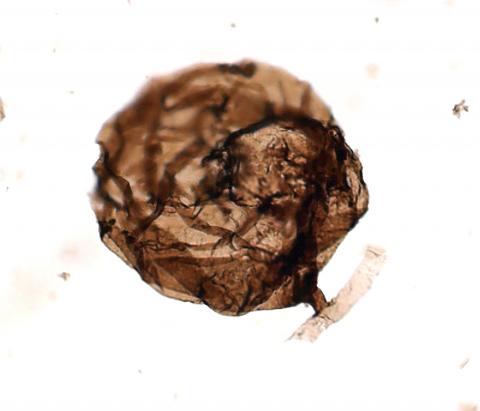Microfossils of a globular spore connected to a T-shaped filament excavated in an Arctic region of northwestern Canada represent the oldest-known fungus, a discovery that sheds light on the origins of an important branch in Earth’s tree of life.
Scientists said on May 22 the multicellular fungus that they named Ourasphaira giraldae — forerunner to an immensely diverse group that today includes the likes of mushrooms, yeasts and molds — lived in an estuary environment about 900 million to 1 billion years ago. Until now, the oldest-known fungus fossil was one about 410 million years old from Scotland.
Fungi play a crucial role in global ecosystems such as the organic decomposition process. Fungi belong to a broad group of organisms, called eukaryotes, that possess a clearly defined nucleus and includes animals and plants. A fundamental difference between fungi and plants is that fungi are incapable of photosynthesis, harnessing sunlight to synthesize nutrients.

Photo: REUTERS
照片:路透
Because of a close evolutionary relationship between fungi and animals, the researchers suspect that early forms of microscopic animal life may have lived at the same time as Ourasphaira. The earliest fossils of rudimentary animals are about 635 million years old.
“Fungi are one of the more diverse groups of eukaryotes known today and, despite this, their ancient fossil record is very scarce,” said paleobiologist Corentin Loron of the University of Liege in Belgium, lead author of the research published in the journal Nature.
The microscopic fossils, contained in shale rock from the Northwest Territories of Canada, dated to the Proterozoic era, before the advent of complex life forms. The fossil record from that era “is still a mysterious jigsaw puzzle, and we just added a new piece to it,” Loron said.
In determining that the fossils were of fungi, the researchers identified the presence of a fibrous substance called chitin, a key fungal characteristic, in Ourasphaira’s cell walls. Chitin is also present in the durable exoskeletons of invertebrate animals such as insects and crustaceans.
“Of course, when talking about fungi, we think of poisonous mushrooms or mold that grows on food,” Loron said. “But fungi are also well known to help productivity in cultivated fields, for fermentation purposes like yeast in beer, or for their role in the digestive system — for example, in the rumen of cows — to help cellulose digestion.”
(Reuters)
內含一顆球狀孢子的微化石,近日出土於加拿大西北部的北極圈境內。此孢子跟某種T形的絲狀結構相關,被認為是目前所知最古老的真菌。這項發現提供新的線索,能夠闡明地球生命之樹一段重要分支的起源。
科學家於五月二十二日表示,這種多細胞真菌被命名為「Ourasphaira giraldae」,是今日包括各種蘑菇、酵母菌、黴菌在內,整個龐大而多元的真菌類族群祖先,並且大約於九億到十億年前之間生長於河口環境。在此之前,最早的真菌化石來自蘇格蘭,出土地層年代約為四點一億年前。
真菌在全球生態系統中扮演著舉足輕重的角色,是生物分解等過程中不可或缺的一部分。它們隸屬於生物界中稱為「真核生物」的大型族群,具有明顯的細胞核,真核生物族群也包括動物和植物。真菌跟植物根本上的差異在於,真菌無法行光合作用,也就是利用陽光的能量來合成營養物。
另一方面,由於真菌和動物在演化上關係密切,科學家推測微型動物早期的生命型態可能和Ourasphaira生活在相同的時代。目前最古老的早期動物化石來自於大約六億三千五百萬年前。
這份研究日前發表於期刊《自然》,第一作者是比利時列日大學的古生物學家科倫丁‧洛隆,他表示:「在今日所知的真核生物群體中,真菌是比較多采多姿的一個族群。儘管如此,它們留下來的遠古化石卻是相當稀少。」
這批微化石來自加拿大西北特區的頁岩層中,年代可以追溯到元古宙時期,早於複雜生命型態出現的時間。洛隆表示,該時期留下的化石紀錄「仍然像是神秘難解的拼圖,而我們剛剛才加進一片新的拼圖。」
在確認這批化石是否屬於真菌類的過程中,研究人員在Ourasphaira的細胞壁中辨認出稱為「幾丁質」的纖維狀物質,這是真菌類的特徵。幾丁質中文又名「甲殼素」,亦可見於無脊椎動物堅硬的外骨骼中,例如昆蟲和甲殼綱動物。
「當然,談到真菌的時候,我們就會想到毒蘑菇或是長在食物上的黴菌,」洛隆指出:「但是真菌在很多領域都聲名遠播,例如改善耕種過後田地的生產力,也有發酵的用途,像是啤酒中的酵母菌,又或是在消化系統──例如在牛隻的瘤胃中──扮演著幫助消化纖維素的角色。」
(台北時報章厚明譯)
DID YOU KNOW?
你知道嗎?
In the scientific name Ourasphaira giraldae, the generic name Ourasphaira comes from the combination of “tail” and “sphere” in ancient Greek words to describe the fungus filament having a “ball-shaped structure” connected to the “tail.” The specific name giraldae is named in honor of M. Giraldo, who dedicated her professional life to the preparation of palynological samples at the University of Liege.
拉丁文學名「Ourasphaira giraldae」,前半部的屬名「Ourasphaira」來自於古希臘文的「尾巴」與「圓球」,描述這類真菌的絲狀結構末端和一個球型結構相連,而物種小名「giraldae」則是為了表彰列日大學的Giraldo女士長期收集孢粉學研究材料的貢獻。

A: When is the Lantern Festival? B: The festival is celebrated on the 15th day of the first month of the lunar calendar, which fell on Feb. 12 this year. A: Oh no! Did I miss the 2025 Taipei Lantern Festival? B: Yes, you did. But you can still go to the 2025 Taiwan Lantern Festival in Taoyuan, which will run until this Sunday. A: Let’s go admire the exuberant lanterns. A: 元宵節到底是哪一天? B: 就是農曆1月15日啊,今年則落在國曆2月12日。 A: 喔不,我是不是錯過了2025台北燈節? B: 是的,但你還可以去桃園的2025台灣燈會,活動將持續至週日。 A: 那我們去欣賞豐富的花燈秀吧! (By Eddy Chang, Taipei Times/台北時報張聖恩)

A: What’s the theme of the 2025 Taiwan Lantern Festival’s main lantern? B: The theme is “Paradise,” and the main lantern is a snake-shaped “infinity” symbol that features a lighting show every half an hour. A: Cool, I heard that there are over 300 lanterns. B: There are even giant lanterns in the shape of Pikachu and some other popular Pokemon characters. A: Let’s go now. A: 2025台灣燈會主燈的主題是什麼? B: 主題是「無限樂園」!主燈的造型則是蛇形的數學「無限號」,主燈每半小時還有一次燈光秀。 A: 酷喔,聽說總共有300多件花燈作品。 B: 甚至還有皮卡丘和其他熱門寶可夢角色的巨型花燈呢。 A: 哇我們現在就出發吧! (By Eddy Chang, Taipei Times/台北時報張聖恩)

本文由生成式AI協作,本刊編輯編修。 Tucked away in southwestern Taiwan, Yunlin County is a treasure trove of cultural heritage, rich history, and natural beauty. From its stunning temples and glove puppetry to historical architecture and picturesque landscapes, Yunlin rewards those who venture off the beaten path. Yunlin is renowned for its flourishing temple culture. Temples in this region are not merely places of worship but also communal centers where people gather for festivals, rituals, and social functions. One of the most notable temples here is the Beigang Chaotian Temple, which was built more than 300 years ago and is dedicated to Matsu, the sea

Nestled within the heart of Taipei, National Taiwan University (NTU) contains a grand and spacious sanctuary where nature and academia come together in perfect accord. Across its expansive 111-hectare campus, NTU reveals a landscape rich with history, lush greenery, and a thoughtfully preserved ecosystem. This tranquil haven invites visitors to take their time wandering among the elegant buildings, to admire the rare plants, and to experience a space that exudes quiet inspiration. Zhoushan Road: A Gentle Prelude to NTU’s Tranquility Beginning at Gongguan MRT Station, the enchanting avenue Zhoushan Road leads visitors into NTU shaded by golden rain trees, cottonwoods, and Javanese